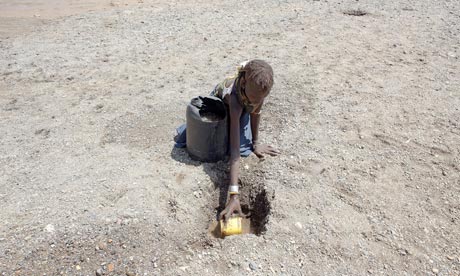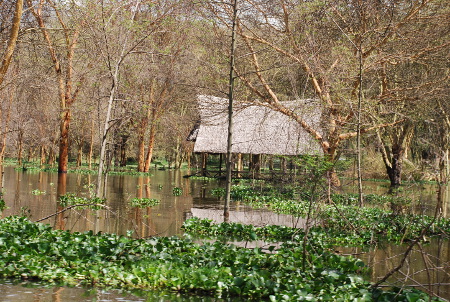Kenya is training for tomorrow's technology leaders to deal with today's climate and energy problems
by John Abraham, "Climate Consensus - The 97%," The Guardian, January 12, 2014

A young girl in northern Kenya digs a hole in a river bed to retrieve water. Parts of Kenya are hit by drought as other areas get excessive rains. Photograph: Christopher Furlong/Getty Images
Much of my work involves the design and installation of clean and robustenergy sources in remote parts of the world. On a recent trip to Kenya, my family had the opportunity to tour the Lake Naivasha region in Kenya. This region contains a treasure of wildlife and was a filming location for the movie "Out of Africa." During a boat ride, we witnessed the impacts on climate change – not through academic journal articles or conference presentations – but through people who see climate change with their own eyes.
In past years, Lake Naivasha had seen dramatic reductions in water level. The coastline had changed and plants and animals had adapted to a new normal. Recently, however, extreme rains have raised the waters approximately 4 meters according to our guide. The new waterline had submerged and killed beautiful Acacia trees. After conversations with many other Kenyans, it was apparent that the reliable wet-dry weather patterns had become more erratic; you didn't have to witness dying Acacia trees when farmers throughout the country told similar tales. Extreme weather swings were evident here before our eyes.
 Flooding in Western Kenya, submerged buildings and Acacia trees.
Flooding in Western Kenya, submerged buildings and Acacia trees.
Kenyan culture (and much of Africa) is deeply rooted in the patterns of weather and climate; much of their economy depends on agricultural production. That dependency has given them much clearer foresight than others about how to plan for the changed future.
The entirety of Kenya has awakened to the threats of climate change, including the government, agricultural sectors, energy industries and the educational system. My journey to learn more about Kenya's plans brought me to the beautiful and large Kenyatta University campus, just northeast of Nairobi. There, very new and quickly growing programs in mechanical engineering, energy and sustainability, and agricultural engineering are just a few of the programs training tomorrow's technology leaders to make an impact solving today's problems.
Among the many initiatives are goals to provide clean, renewable, and robust energy for the campus and the country. Some applications they are focusing on are wind-powered water-pumping systems. The plan is to design, manufacture, install, and service small-scale wind power systems that slowly pump water into elevated storage tanks throughout the day and night. Students, faculty, and staff draw the water is drawn down, typically during morning and evening hours. The prototype wind turbine will be adapted to manufacturing techniques used locally, near the university. It is hoped that wide-scale testing of the wind turbine system will occur over the next three years and thereafter, fast market penetration throughout Africa will be inevitable.
Another emerging technology coming from Kenyatta is the use of novel technologies for heating, ventilation, and air-conditioning (HVAC). By using thermochemical sorption technologies, sometimes with solar heating, Dr. Jeremiah Kiplagat (recent recipient of the African Education Leadership Outstanding Professor Award) and his colleagues are setting the framework for improving the performance of refrigeration systems using these methodologies.
As a third example, a series of faculty-led student projects have been completed to develop solar concentrating and tracking systems for heat generation and photovoltaic power generation. The research teams have developed effective and simple means of moving reflecting mirrors and parabolic concentrators with the sun throughout the day to increase the amount of absorbed solar energy and increase the efficiency of the overall system.
While the faculty and staff are at the forefront in technology development projects such as these, much credit must be given to the administration. With implementation of new degrees such as doctoral programs in sustainability and masters programs in mechanical engineering, electrical engineering, engineering hydrology, and biomedical engineering, with a focus on solving the energy and health problems that are prevalent in the East African region, this university, and the country as a whole are destined to remain leaders in their geographical region.
It is clear from formal academic studies and from anecdotal evidence that developing countries that rely upon agriculture will suffer greatly from climate change in the coming decades. It is hence apparent that the solutions to climate change, such as accelerated implementation of clean and renewable power, must be implemented with great wisdom so that people in these regions are able to access the same low-cost electricity that other nations have enjoyed. In this regard, the climate-energy problem is often thought of as a double-edged sword – solutions to the climate problem make access to low-cost electricity more difficult.
Currently, the major source of energy in Kenya is hydropower. This is why the School of Engineering at Kenyatta University has also partnered with regional and international organizations to promote climate mitigation in water and energy sectors. An example is the research being carried out by Dr. Luke Olang in collaboration with IGAD climate center on developing a drought-monitoring tool for the greater horn of Africa in general. The same research team is also actively involved in water management strategies in the vulnerable Mara River Basin, considered a World Heritage site due to the Great Annual Wildebeest Migration.
What Kenyatta University is showing the world is that it is possible to solve both the energy and the climate problems together. Novel energy solutions using locally available technology and manufacturing techniques can build economies, provide low-cost energy, and preserve the future climate for our children. This type of systematic planning and dedication gives me hope that our future climate and energy problems can be solved.
Perhaps the vision is best expressed by Prof. Chris Shisanya, Dean School of Humanities and Social Sciences who told me,
"We at Kenyatta University have decided to prepare our students early enough during their study programmes to confront the challenges posed by climate change. We are now offering such courses as MSc. (Integrated Watershed Management) and MSc. (Climate Change and Sustainable Development), whose main focus is on adaptation to climate change. We believe that by exposing our students to such knowledge, they will be better equipped to help communities in Kenya's rural landscapes enhance their resilience to climate change impacts."
http://www.theguardian.com/environment/climate-consensus-97-per-cent/2014/jan/12/global-warming-energy-intertwined-africa







3 comments:
Thanks for sharing.
Thanks for sharing this article, good work!
You're welcome, Gabu -- wish there was a lot more research on that continent.
Post a Comment